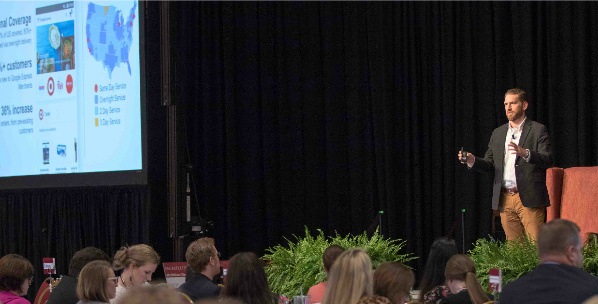Google strategist talks changing internet search trends at tech conference in Rogers
by April 27, 2017 5:17 pm 575 views

Ben Emmrich, strategic partner developer for Google, addresses the crowd at the Trends in Technology Conference on Wednesday (April 26) at the John Q. Hammons Center in Rogers.
Search providers need to “get smarter” about connecting people to information in an accurate and helpful way, said Ben Emmrich, strategic partner developer for Google.
He spoke on “reaching today’s customer,” as the keynote speaker at the Trends in Technology Conference on Wednesday (April 26) at the John Q. Hammons Center in Rogers. The event was presented by the University of Arkansas Supply Chain Management Research Center and the Center for Retailing Excellence at the Sam M. Walton College of Business.
“The traditional confines of what search means needs to evolve,” he said. “It’s no longer just 10 blue links on a page. It’s no longer 10 blue links, plus five ad links,” he said.
Mobile voice searches are a key driver of change. May 2015 was the “tipping point,” Emmrich said, where mobile queries outpaced desktop searches for the first time. Since then, “that trend has only accelerated.”
Now, mobile searches make up 60% of internet queries, and many of those are made using voice, he said. “We now see trillions of voice searches per year.”
Market researchers predict voice searches will make up about half of searches by 2020.
Emmrich said one way search providers can improve is by being “more personable,” understanding the user and his or her environment and how data can be applied in an accurate and helpful way — and helpful means nonintrusive, he said.
“Google is now at the cusp of a new frontier for search,” and that future is in Google Assistant, an artificial intelligence-based search platform, and the first device powered by the service, Google Home, Emmrich said. Soon, the service also will be available on Android devices, he said.
“You can imagine a world in which your profile with the Google Assistant and with Google products writ large follows you in a helpful way across different devices and platforms, and this shifts toward a more intelligent voice-powered search, where we anticipate users’ needs and can meet them in that moment of need with a quality answer,” Emmrich said.
‘PARADIGM SHIFT’ IN RETAIL INDUSTRY
One industry that is going through transition because of mobile technology is shopping, he added. “We are in the midst of a paradigm shift in retail.”
He pointed to the Amazon Dash button as an adaption for the changing world. “It’s a great way to reduce friction in a transaction, and it also puts the transaction in context for the user, in the actual place where they use that item,” Emmrich said.
He also pointed to subscription services that “reduce friction” and have a model that allows them to offer high-quality items at a lower rate than the market standard.
Emmrich said Google is responding with its direct-from-merchant shopping tool, Google Express, which offers same-day, overnight or two-day delivery, depending on where you live.
In terms of more forward-thinking technology, virtual and augmented reality are increasingly playing a role in retail.
For example, Gap looked at the fact that consumers who tried on clothes in a fitting room were 70% more likely to make purchases and in higher volume, and the retailer is now testing a virtual fitting room app, where customers can choose their size and body type and virtually try on clothes on their smartphone.
Emmrich said use of the app has had similar impact on buying frequency to that of in-person dressing room use.
GOOGLE’S FUTURE
Two products that Google deems as having the potential to be impactful in retail are Purchases on Google and Local Inventory Ads.
The company calls Purchases on Google a “transactionable ad unit.” Users have the option to check out within a Google search results or continue to a retailer’s site. Emmrich said while the product is still in its early days, “it is seeing incredibly strong results,” especially with retailers that are having trouble with mobile conversion rates.
Also, Emmrich purports that more than half of customers for Purchases on Google are first-time shoppers for those brands. “So, it’s not just a sales driver. It’s a customer driver.”
Local Inventory Ads provides geographically specific product information, using both online and offline data, he said. “If you search for ‘headphones near me’ on Google Maps, we would show a store with headphones in stock that we think are relative to that user, direct that user to the store, and then we can then track that on the back-end.”
In terms of shopping with Google Assistant, Emmrich said if he was searching for sunglasses to buy, the technology would know that he was between 30 and 40 years old and that he lives in San Francisco and, based on the buying trends of those demographics and other information — like, for example, that he recently returned a pair of Ray-Ban glasses — would make suggestions to help direct his shopping, or put the order through, add it to a shopping list or remind him to make the purchase later.
“It would understand the context: where I am, what I’m doing, what I’ve done in the past, so that Google via the assistant can provide relevant and helpful information to help me make the best decision more efficiently,” Emmrich said.
